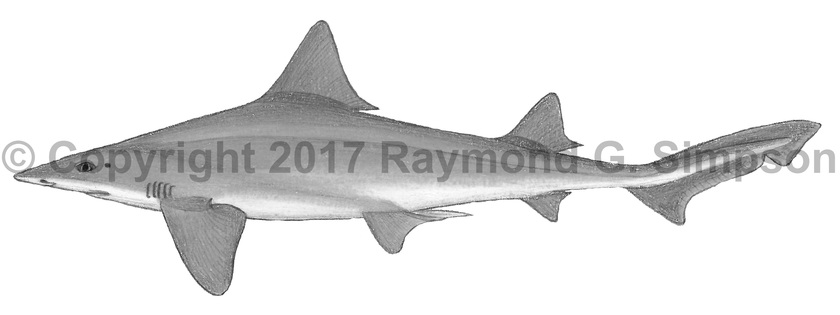
Common Name
Smalleye Smoothhound
Year Described
Springer and Lowe, 1963
Identification
A small and slender shark with two large dorsal fins. Mouth with labial furrows equal in length. Teeth small and low with stumpy cusps. Upper jaw: 65-75 rows. Lower jaw: 62-70 rows. Eye large with a prominent spiracle less than eye diameter behind it. Snout short (>7.1% TL). Nostril with projecting tabs. Distance between nostrils 2.7-3.8% TL. Dorsal fins lack spines. Second dorsal fin about 75% as high as the first. First dorsal origin over rear base of pectoral fin. Second dorsal fin origin anterior to anal fin origin but well behind pelvic free tip. Pectoral fin with rounded tip. Pelvic and anal fins much smaller than second dorsal fin. No precaudal pits. Caudal fin with a prominent rounded lower lobe. Skin with overlapping *tri-pointed denticles with 4 ridges.
Color
Body ranges from grey to brownish to golden brown above. Live specimens frequently show the golden pattern which fades to gray with death. Belly pale. No markings on body.
Size
Maximum size to 64cm TL.
Habitat
A shallow water species occurring from 8-110m.
Range
Known from the coast of South America from Venezuela to southeastern Brazil.
References
Compagno, L., M. Dando, and S. Fowler. 2005. Sharks of the World. Princeton University Press, 480 pp.
Heemstra, P.C. 1997. A review of the smooth-hound sharks (genus Mustelus, family Triakidae) of the western Atlantic Ocean, with descriptions of two new species and a new subspecies. Bulletin of Marine Science, 60(3), 894-928.
Rosa, M.R., & O.B.F. Gadig. 2010. Taxonomic comments and an identification key to species for the Smooth-hound sharks genus (Mustelus Link, 1790) (Chondrichthyes: Triakidae) from the Western South Atlantic. Pan-American Journal of Aquatic Sciences, 401-413.
Other Notes
Mustelus higmani and M. norrisi are similar to each other but differ in denticle morphology and snout length (Heemstra, 1997).